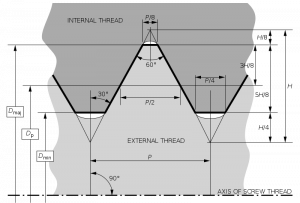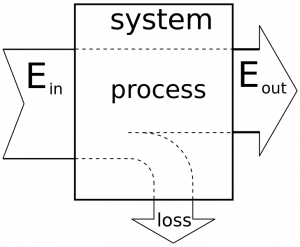1 What is Industrial Engineering?
Chapter Table of Contents
- Examples of Industrial Engineering Improvements
- IE Definition
- Efficiency vs. Effectiveness
- Goals of this Text
- Welcome to Industrial Engineering
- Chapter Exercise
Examples of Industrial Engineering Improvements

- An IE at a hospital worked with a team to redesign the process for cleaning an operating room and preparing it for the next operation. The time between scheduled operations was reduced from 45 to 20 minutes. More operations can be scheduled in each operating room each day.
- A manufacturer of corporate jets opened a new facility to manufacture tail sections. An industrial engineer (IE) laid out the new facility, including deciding where material would be delivered, where each machine used in the manufacturing process would be located, how work would flow through the facility, and where finished sections would be shipped from the facility.
- A large air chiller has a compressor that is housed in a steel cylinder. The cylinder was being made by bending and welding two pieces of steel. An IE redesigned the cylinder and the manufacturing process so that the cylinder is now made by bending and welding one piece of steel. The manufacturing process takes less time and the cylinder is stronger.

- A plant that assembles lawnmowers found that bolt holes on parts were not always lining up properly. An IE gathered and analyzed data to determine the source of the problem. The IE found that parts from a particular supplier were not meeting the tolerances that had been specified. The IE worked with the supplier to improve their production process so that the tolerances were met in the future.
- An IE found that the number of back injuries in an automobile assembly plant was increasing. The IE analyzed the safety reports on such injuries from the last year and found that the increase was occurring in the engine assembly area; further investigation showed that a redesign of the engine had made the engine assembly awkward. The IE worked with the assembly workers to redesign the assembly task, including the purchase of a new hoist. The IE monitored the safety reports over the next three months and found that the rate of back injuries had declined.
Industrial Engineering Definition
These examples illustrate different features of this definition of industrial engineering:
The design or improvement of a system of people, machines, information, and money to achieve some goal with efficiency, quality, and safety.
Certain words are show in bold face in the definition:Design – Some industrial engineering tasks involve the creation of a new facility, process, or system.
- Improvement – Most industrial engineering tasks involve the improvement of an existing facility, process, or system.
- System – Most engineers design physical objects, but most IEs design systems. Systems include physical components, but also include processes, rules, and people. Components of a system have to work together. Material and information flow between the components of a system. A change to one part of system may affect other parts of the system.
- People – Among all types of engineers, IEs think the most about people.
- Machines – An IE must select the appropriate machines – including computers.
- Information – Data can be used for immediate decision making but can also be analyzed to make improvements to the system.
- Money – An IE must weigh costs and savings now against costs and savings in the future.
- Goal – Every designed system exists for some purpose. The IE must think about different ways to accomplish that goal and select the best way.
- Efficiency – Whatever the goal of the system, the IE usually seeks to have the system achieve that goal quickly and with the least use of resources.
- Quality – The IE’s organization always has a customer and the organization must deliver goods and services to the customer with the quality that the customer wants.
- Safety – IEs have to make sure that the system is designed so that people can and will work safely.
Efficiency vs. Effectiveness
IEs are sometimes called efficiency engineers, but some think that effectiveness engineer is more accurate. What is the difference between being efficient and being effective?

-
- An efficient process doesn’t waste any time or resources.
- An effective process produces a desired effect or contributes to a desired goal.
Two words in our definition of industrial engineering (efficiency and goal) relate to these two aspects of an IE’s job. A process can be effective but not efficient if the process could be done as effectively but in less time or with fewer resources; for example, the time to produce a product might be reduced without any loss of customer satisfaction with the product. A process can be efficient but not effective; for example, a department that efficiently produces reports that no one uses is not effective.
The words in bold face in the definition also indicate areas that an IE must learn about. An IE must know how to answer questions like these:
- Design and improvement – Where should a facility be located? How should all the components be laid out physically? What operating procedures should be used?
- System – How should the tasks be allocated among different parts of the system? How should material and information flow among the different components of a system?
- People – What are people good at? What types of tasks should not be assigned to people? How can jobs be designed so that people can do their jobs quickly, safely, and well?
- Machines – What types of machines are available to do different tasks, including the movement and storage of material and information?
- Information – How can data be used to determine how well the system is functioning?
- Money – How can we trade off costs and savings that occur at different times, maybe over a number of years?
- Goal – What is the goal of this system? What are the different ways a system could achieve that goal?
- Efficiency – How can we produce products and services with the least amount of time and resources?
- Quality – How can we make sure that the system is consistently producing goods and services that meet customer needs?
- Safety – How can we keep people from making mistakes? How can we protect people from hazards in the work place?
Goals of this Text
After you have read this book, you should have:
- An understanding of the types of work IEs do in different types of organizations.
- The ability to explain to others what IEs do,
- The ability to market yourself as an IE,
- An overview of the topics in a BSIE curriculum,
- An understanding of the context in which IEs work, including global and societal issues,
- A commitment to professional and ethical behavior now and in the future, and
- Improved professional skills, especially oral and written communication skills and teamwork skills.
This course will not turn you into an IE since you can’t learn all the knowledge and skills that an IE needs in just one semester, but it will start you on your way to becoming an IE. You will have the Big Picture of industrial engineering, so that the ideas you learn in later courses fit together.
Welcome to industrial engineering
Being an IE is very satisfying because you can create an efficient and safe workplace where people are proud of the high quality products and services they produce. IEs improve efficiency, which means that we help bring prosperity. IEs improve quality, which means that we help provide good products and services. And IEs improve safety, which means that we help protect people. You should be very proud that you plan to become an IE. According to the bumper sticker version of industrial engineering, IEs make things better.
Exercise
Which list is better if becoming an Industrial Engineer is your number one priority?

